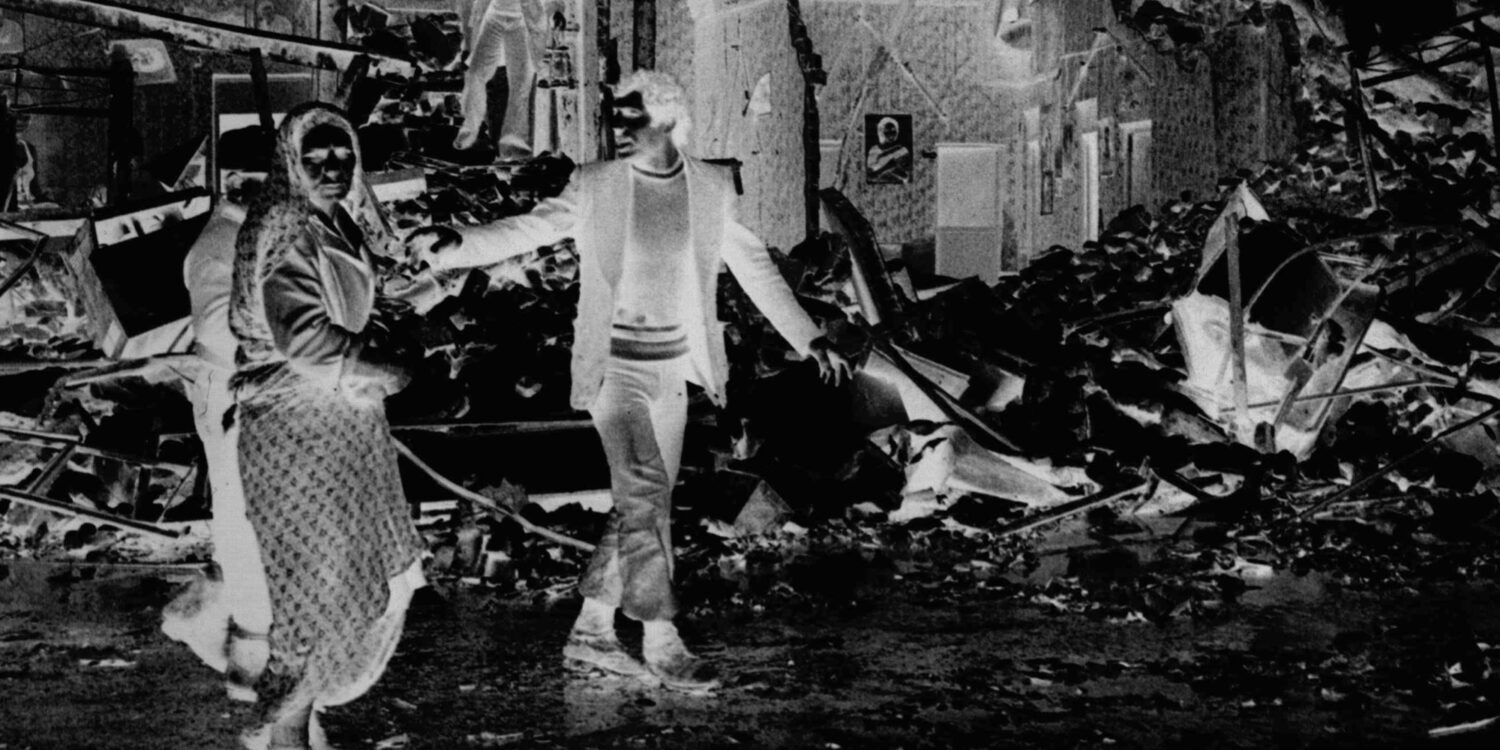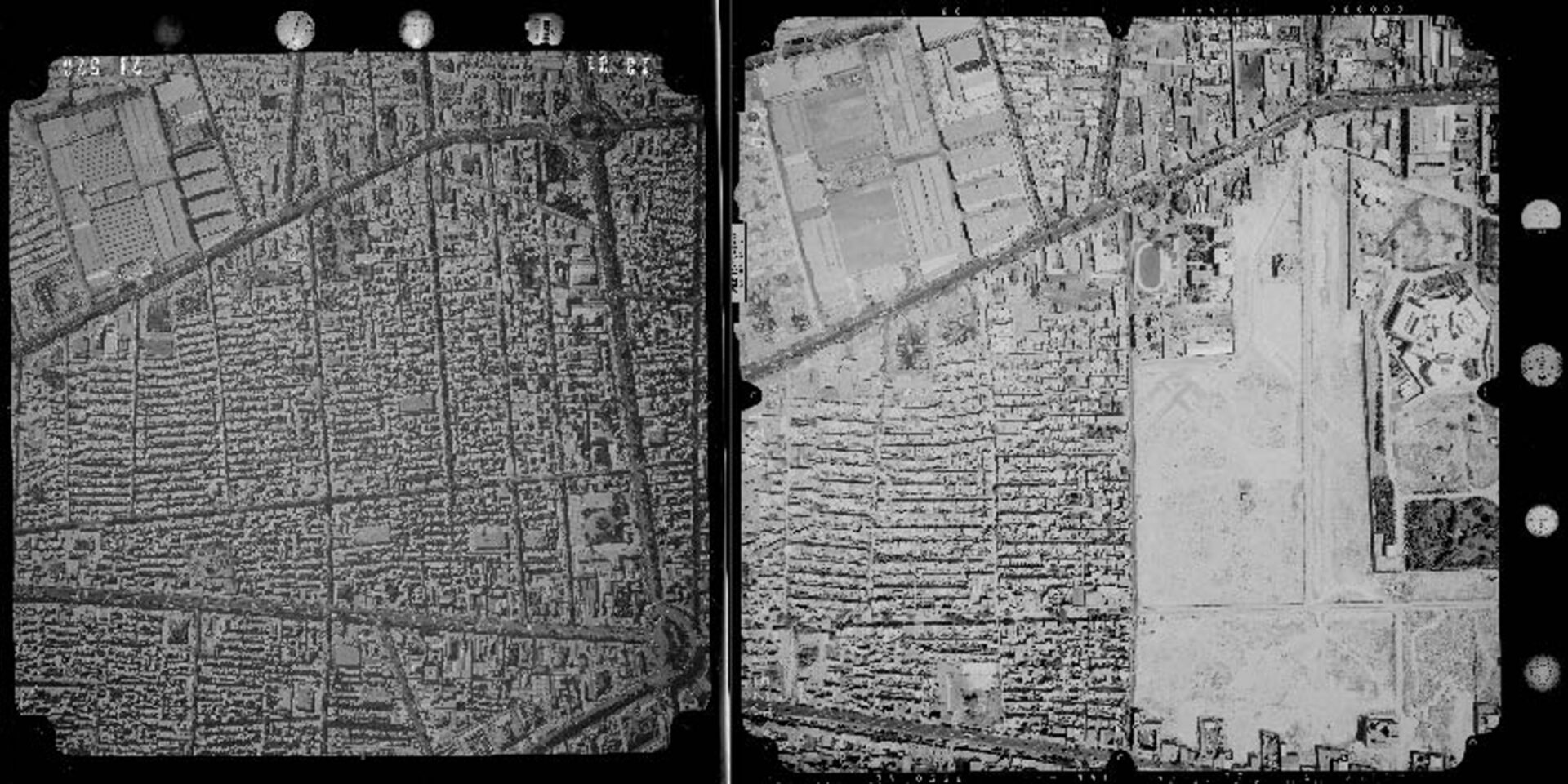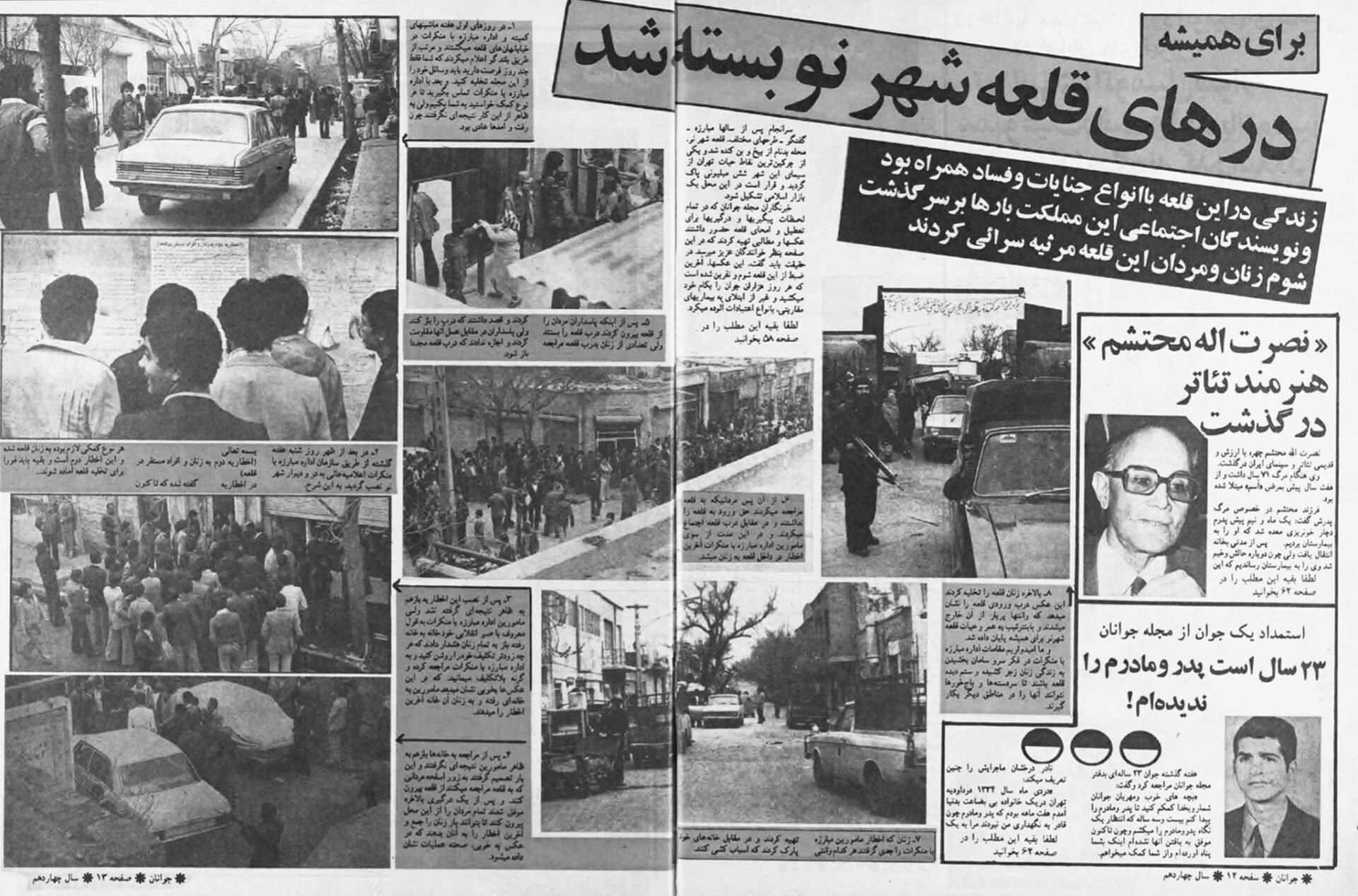I received an urgent telephone call from a welfare center we had established for the women of the red-light district – it was known as the “Ghaleh,” or fortress, because it was enclosed by a wall. The frantic director told me that a crowd… was threatening to burn down the entire Ghaleh, and the police and fire department refused to help… By the time we arrived at the welfare center, black smoke was rising from a few wretched little houses nearby. Several women stood in the street, screeching with rage and fear and cursing their persecutors.
– Sattareh Farman-Farmaian, Daughter of Persia
It was 29 January 1979 and against a backdrop of violent events in the streets of Tehran, the revolutionaries were getting ready to receive Ayatollah Khomeini back in Iran after fourteen years of exile. We still do not exactly know why, but on that cold day in the middle of winter, the revolutionary crowd embarked on a witch-hunt, marching towards the south of Tehran to vent their rage on the walled area of “Shahrinaw”. Around midday, the large crowd gathered and set Shams brewery on fire. On their way to Shahrinaw, they attacked multiple bars, cafes and cabarets. By five in the evening, Shahrinaw was surrounded and soon the crowd – some of whom had no doubt been regular visitors – broke the main gate, poured into the neighbourhood and set the ward on fire. The police and fire department withheld their assistance till the infamous red-light district of Tehran succumbed to the crowd’s wrath.
Smoke, dust, shouting and commotion; A large crowd is watching… Women are running out of burning houses barefoot and bare-headed, screaming and coughing… They find themselves in a circle of angry men hitting them with belts, sticks and brass knuckles. A vigorous man comes forward and cuts a woman’s long hair… [another woman shouts:] How come yesterday’s clients became religious all of a sudden?
– Bahram Beizai, Screenplay for his never-shown film Facing Mirrors (1981) (excerpt translated from the original Farsi)
Shahrinaw’s physical removal created a spatial void in the middle of Tehran for almost two decades after the Iranian Revolution of 1979. Eventually, in 1997, the space was finally put to use again when the Tehran Municipality inaugurated the Razi park and cultural complex, which includes a variety of public services such as a library, movie theatre, artificial lake and an amusement park. It’s a far cry from the area’s previous functions. Nonetheless, some traces of the demolished neighbourhood remain visible on the street edges, haunted buildings and ruins complementing the hazy collective memory of Shahrinaw, which is still present in the minds of a few surviving witnesses, including an elderly regular customer of a local teahouse in Pasgah cul-de-sac – the location of the former police station of the neighbourhood, who was happy to share his vivid memories of the streets, brothels, madams, cafés and bars. While pointing towards an empty plot of land and a few last remnants of Shahrinaw, and recalling the liquor stores, cabarets, cinemas and cafes, he did not shy away from expressing his yearning for the long-lost red-light district and the time when men knew where to pursue illicit pleasure. Nevertheless, nowadays, Tehran citizens, most of whom are under the age of forty, can hardly recall Shahrinaw, its inhabitants and the story behind its removal.
“The (hi)stories we tell of cities are also (hi)stories of ourselves,” writes Jane Rendell in her book In Pursuit of Pleasure. By writing about cities and spatial experiences, we create new cities and new selves. Writing the Shahrinaw’s creation and erasure into the history of modern Iranian women is important not least to frame it as a history marked by women’s struggle to claim their share of public space. This social history is saturated with defining moments such as forceful unveiling in 1936 and forceful re-veiling in 1979, when Iranian women were targeted by top-down interventions and subjected to the socio-political authority of a patriarchal society that portrayed them as the property of men. As Farzaneh Milani puts it in her book Veils and Worlds, within these kinds of interventions, women are conceived as the embodiment of their nation’s dreams and nightmares. “They become”, she writes, “an idiom of political and religious expression, an emblem of national identity”. Against this, the spatial history of Shahrinaw represents an extreme case of gender-based segregation shaped by a web of complex discourses around policing, Islamic rules, moral codes, and hygiene. By re-imagining this spatial history and exploring, writing and narrating the everyday life of the inhabitants of Shahrinaw, a new Tehran can be conceived in which excluded bodies and practices are made visible.
By the end of the 19th Century, increased trade and diplomatic connections with Europe exposed Iran to Western science, technology and educational methods, which in turn became a starting point for social reforms in the country. Being the capital of Iran, Tehran was among the first places where citizens got to witness the consequences of these reforms. The construction of the first public park, modern streets and the introduction of a public transport system increased people’s mobility and offered new sites of sociability, entertainment, and transaction. Such transformations opened the city’s public space to women for the first time and enabled them to claim a part of the public domain. At the same time, the formation of the national army in Tehran and an array of geopolitical conflicts, namely the division of Iran by the 1907 Anglo-Russian Convention and the First World War, along with internal migration waves, set the stage for an unprecedented increase in Tehran’s male population, a condition which indirectly prompted a surge in sex work.
With the establishment of a modern police force in 1878 in Iran, the government introduced new legislation that tacitly decriminalised the selling of sex while at the same time restricting its scope through the criminalization of other related acts such as haggling over the price of buying sex, and other “vices” such as wine drinking, gambling, and animal fighting. Consequently, the punishments for women caught selling sex were often very arbitrary. On some occasions, they were fined or jailed or forced by police to perform community service. Police reports from the Muzaffarī period (1896–1907) show that the most common punishment for women caught selling sex was a practice known as nafie-balad. This was a form of forceful banishment or eviction from the city targeted at sinful, criminal and undesirable subjects and those who defy social and moral conventions of the society, in a move that calls to mind the notion of “dirt” put forward by the British anthropologist, Mary Douglas. In her 1966 book Purity and Danger, Douglas famously frames dirt as “matter out of place”, arguing that what constitutes dirt is particular to a given culture, and associated with bodies, practices or objects that disrupt or contravene orthodox classifications and understandings of the world. Douglas’ book observes the various ways in which these dirty elements must be physically removed or isolated, an observation with echoes in Michel Foucault’s concept of “biopower,” part of which describes the ways that power is expressed through and inscribed on bodies by way of public health. To the authorities and the public at large, the bold presence of sex workers in the public urban space of Tehran during the first decades of the 20th century was deemed as a sign of moral corruption and pollution, a threat to the social institutions of family and marriage that needed to be swept away.

Aerial photo of southwest Tehran depicting the early stage of demarcation of Shahrinaw. The broad circular field at the back is the Bagh-e-Shah garrison on the west of Tehran; the two streets at the front are Jamshid street (left) and Qavam-daftar (right). Jamshid Street will later become the eastern border of Shahrinaw where the wall will be erected, Qavam-daftar Street will later serve as one of the two main streets within Shahrinaw.
Walter Mittel Holzer, 1925. ETH-Bibliothek Zürich.
Public discontent came to a head at the end of the 1910s with the first series of petitions in 1919 calling for sex workers to be banished from Tehran. The historical evidence suggests that the first traces of Shahrinaw (which means “the new city” in Farsi) in the periphery of Tehran appeared only a decade prior to these petitions, around 1907-09. The political figure and writer Hassan Ezam-Qodsi notes that sex workers from Qajariyah alley in Tehran were moved to this new neighbourhood in order to avoid sexual assaults on “respectable” women in the city. Ezam-Qodsi then illustrates a clear image of the relocation process. One day, all the women suspected of selling sex were gathered and moved by military trucks to a nearby caravanserai outside of Tehran’s wall: “the wayward women were all thrown in there like sheep… later, houses were built and a neighbourhood took shape which was named Shahrinaw”. The historian Jafar Shahri in the third volume of his book The Old Tehran describes Shahrinaw as a small hamlet outside the Qazvin Gate in the South-West of Tehran that was popular amongst lovers. This area, with its farms and gardens, coffee houses, opium dens and a couple of brothels was favoured by Tehranis as a place to spend their long summer evenings.
With the demolition of the historic wall of Tehran between 1932-34 and the rapid expansion of the city in the next few decades, Shahrinaw soon became one of Tehran’s central neighbourhoods. The district offered its services as usual until the 1940s when public dissatisfaction surged again, leading to a second wave of campaigns aimed at banishing sex workers from the city. In this period, the practice of nafie-balad was again deployed as a tool to address the public concern over the rapid spread of sexually transmitted diseases. As Dutch historian, Willem Floor details in his book A Social History of Sexual Relations in Iran, the result of an STD test undertaken by Pasteur Institute of Tehran in 1929 showed that 43 per cent of the 3,498 participants were tested positive. Furthermore, Floor also cites a report from the Planning Organisation that suggests in 1949 sex work was becoming widespread in Tehran with more than 4,000 sex workers in Shahrinaw and several more undocumented sex workers in the rest of the city. Taken together, this was enough evidence to lead the public to see the body of the sex worker as a source of infection, polluting the air by breathing and the water resources through using public baths. The aforementioned concerns around morality, hygiene and street harassment for “respectable” women in addition to the uncontrolled expansion of the neighbourhood drove the locals to campaign with a series of letters and petitions to city authorities, calling for the confinement or relocation of Shahrinaw from the city. Eventually, in 1953 the municipality bowed to public pressure and ordered the erection of a two-and-a-half-metre tall brick wall around Shahrinaw, restricting entry to a rusty metal gate on the southern edge of the neighbourhood. While the gate was open to men seeking illicit pleasure, women were allowed neither in nor out.
The erection of the wall permanently segregated the neighbourhood’s sex workers from the rest of the city, but, true to Douglas’ concept of dirt (and a fine example of Foucault’s biopower in action), this partition ushered in a period of relative stability in the 1960s and 70s, in which the moral codes of mainstream Iranian society could remain relatively undisturbed while the women could continue their work without too much interference. By this point, the district was 13,500 square meters in area and hosted around 1500 female sex workers, as well as 179 stores, 753 merchants and two theatre houses. During this period, Shahrinaw became a significant source of inspiration for many writers and photographers, albeit mostly male, since women were not allowed into the neighbourhood. One of the most acclaimed representations of the district and its inhabitants is the photographic series “Untitled: The Prostitute Series 1975-77” by Kaveh Golestan, who documented the melancholic life of sex workers of Shahrinaw over the course of two years. Golestan’s representations of sex workers challenged the demonization of the sex worker, casting them not as a source of disease but as someone who needs help to find the right way back into society. Yet as this suggests, even in such sympathetic portrayals, the absence of women’s first-hand perspective helped to create a highly male-centric understanding of the space, in which the women were represented as passive subjects without agency while men took up the role of saviour heroes, casting their gaze over the misery of the sex workers. In these artistic representations, the focus of attention is, of course, the men, either with the purpose of self-promotion of the artist or narrating the story of a male protagonist in a novel or film.

An image from Kaveh Golestan’s photographic series “Untitled: The Prostitute Series, 1975-77”, Tehran, Iran, republished here with the permission of Vali Mahlouji, founder of Archaeology of The Final Decade (AOTFD), a curatorial and research platform and founder of the Kaveh Golestan Estate. AOTFD is the custodian of this series of artworks. AOTFD is responsible for circulating them and exhibiting in public institutions in Europe and Asia alongside its archival display of historical, social, gender and political contexts of Shahrinaw.
However circumscribed, the stability that followed the wall’s erection, in any case, did not last long. It eventually came to an abrupt end following the 1979 Revolution. Shahrinaw continued to function in a state of uncertainty for another year after the Revolution until the Department of the Fight Against Vice issued an order for its demolition. As Jairan Gahan maintains, to warn visitors of the moral implications of visiting Shahrinaw under the new order, a banner was put up at the iron gate: “To the brothers who are the visitors of the ward: What would you have done if other people did such shameful acts to your honour?” Additionally, the authorities served public evacuation notices to Shahrinaw’s remaining residents ordering them to leave the premises as soon as possible. Residents who refused to leave the district – mostly outcast women with nowhere else to go – were forcefully removed from the premises and the doors of Shahrinaw were closed forever in July 1980. The day after, guards stationed within the walls demolished 600 houses over the course of three days.
After the destruction, for many years, the history of Shahrinaw remained an urban myth, somewhere on the threshold of reality and fiction. Along with the eradication of the material traces of Shahrinaw, the state embarked on a heavy censorship agenda, banning the pre-revolutionary novels and movies that had portrayed the neighbourhood or made any reference to it. Additionally, the post-revolutionary discourse around women and their role in society gradually shifted towards celebrating the “mother woman” while deliberately and systematically erasing the “criminal woman” (to use Cyrus Schayegh’s phrasing). The execution of three prominent madams of Shahrinaw is perhaps a clear indication of the new order’s total intolerance of these “out of place” women. In the coming decades, sex work was largely tabooed and the reality of its persistence within society was mostly covered up, while harsh penalties, from fines and jail to execution, were imposed as a deterrent.
Sex workers were among the first groups of women who crossed the threshold separating private and public spaces in modern Tehran. These “deviants” disrupted the long-established patriarchal assumptions about women’s role in society, as well as the very notion of property. As some of the first women to work in public in Iran’s modern era, they set the stage for a new and modern female subject in the city; a condition which resulted in the formation of new gender relations and heavily informed the subjectivity of the modern Iranian woman. At this moment of crisis, these women were occupying an in-between position, stuck between the long-established traditions and new waves of modernization.

An image from Kaveh Golestan’s photographic series “Untitled: The Prostitute Series, 1975-77”, Tehran, Iran, republished here with the permission of Vali Mahlouji, founder of Archaeology of The Final Decade (AOTFD), a curatorial and research platform and founder of the Kaveh Golestan Estate. AOTFD is the custodian of this series of artworks. AOTFD is responsible for circulating them and exhibiting in public institutions in Europe and Asia alongside its archival display of historical, social, gender and political contexts of Shahrinaw.
Iranian society’s treatment of sex workers in the early decades of the 20th Century still reverberates to this day. Being considered “out of place” has now expanded to include a wider range of people considered deviant according to socio-cultural norms and moral frameworks. These include, but are not limited to, Queer people, rough sleepers, drug addicts and of course, women who challenge patriarchal norms. Women are still often unwelcome in public spaces of cities and constant attempts are being made to impose further restrictions on their presence and mobility, forcing them to retreat to the private sphere of the home. As Nazanin Shahrokni has illustrated in her book Women in Place: The Politics of Gender Segregation in Iran, examples of such restrictive spatial prescriptions can be seen in the emergence of gender-segregated parks, universities, clinics, public transport, and sports facilities.
Exclusion is still a central part of the contemporary Iranian women’s struggle to practise their presence in urban public spaces. Iranian women still have a long way ahead to identify, claim and achieve an equal social position in society. Nonetheless, as with many other places around the world, the struggle continues to negate the discriminatory mechanisms in everyday life and solidify their position and agency within society. The story of Shahrinaw, its inception and its violent destruction represents a piece of the puzzle of this ever-present struggle and a vital part of an alternative feminist-spatial history.





